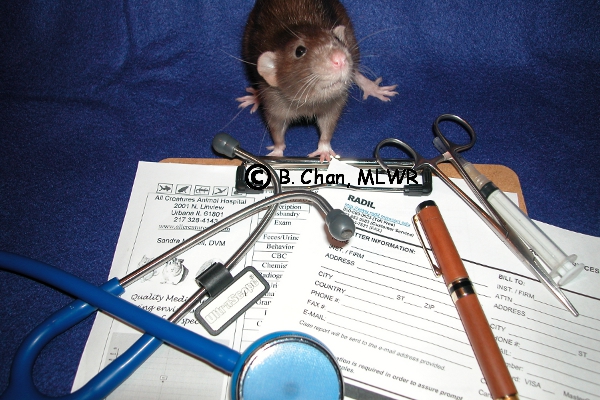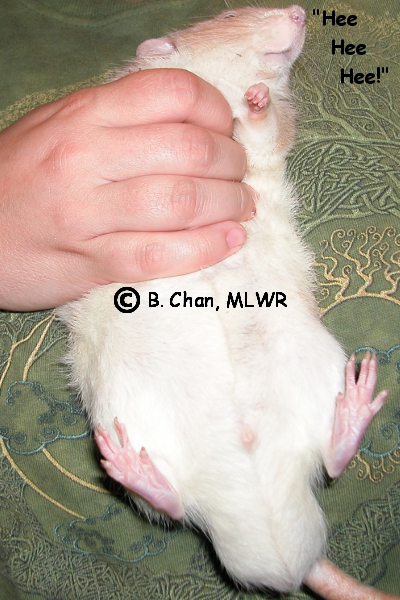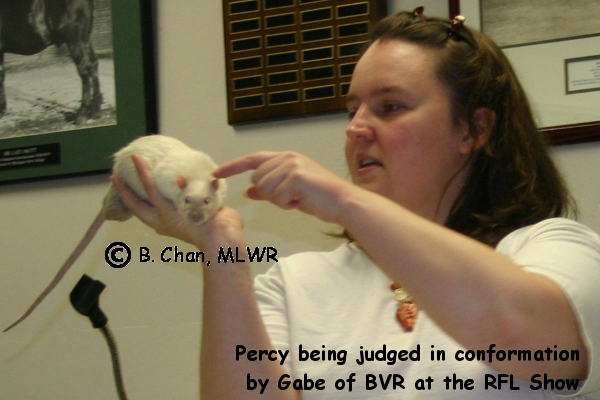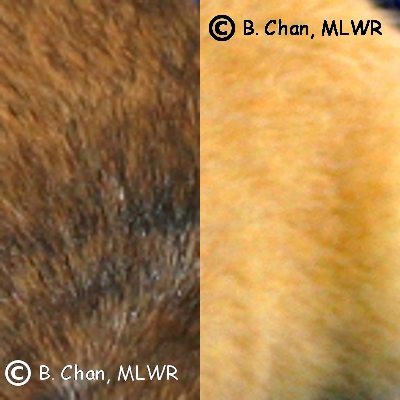

 |
 |
 |
 |
 |
 |
 |  |
 |
 |
 |
 |
 |
 |
 |
There are a lot of people out there who say they are selecting for health and temperament. But what does that really mean? How are they doing it? I will explain a bit here on how we make these selections in our lines and our rattery, since there is more to selection than just saying its what you want to do! We intend to be open about all the health, temperament, and other parts of our lines so that all our adopters and those who work with us are well informed about our animals. Our overall plan is to only breed EXCEPTIONAL animals, not just animals who are acceptable. We want to try and make every pairing be a step forward in improving the overall rat.
Health and Temperament are a given, animals with poor health or temperaments will not be bred at all. We will elaborate a bit more on how we can evaluate overall health and what we use to judge temperament.
 |
|
We want to try and produce healthy animals, and as such we never consider breeding a rat that isn't healthy at the time of pairing! Beyond this obvious bit of selection, we also monitor the health of siblings, parents, grandparents, aunts and uncles, and any other related rats that we can get information on. We look for trends with the health, and look for health problems that seem to be running in the line. Our goal is to select away from these problems, and to try to avoid compounding them when they are seen, doing so by planning our breedings so that we can avoid breeding animals with similar problems in their backgrounds together when possible.
We also have necropsies performed by an experienced veterinarian on all breeding animals, and any animals who die unexpectedly whether or not they are used in breedings, to help us better understand the cause of death, health, and condition when they died. We look for problems with their hearts, lungs, internal organs, and other things that may not be obvious on external observation alone. This data helps us make the best decisions for our lines and help us move forward in improving the health of our rats. We also have blood tests run at least once a year to insure that there are no infections that managed to make their way into our rattery that may be present at a sub clinical level. We have tests run at a qualified laboratory (RADIL) to make sure we get accurate results, and will review any strange findings with our veterinarian as well as with other breeders we work with to ensure we can properly work to keep our rats and others safe, and we post test results on our website as well to keep everyone informed. April 2011: We had a serology test performed by RADIL Lab to test for any problems. Results came back negative with some normal non-specific reactivity on a couple points due to his age. April 2012: We had another seroligy test performed at RADIL Lab. We had a positive for RTV, but this is a virus that does not have clinical effects or an effect on pet or breeding populations, and is only a concern for certain research projects in labs. February 2013: We performed another test through RADIL Lab. We ran it early due to several problems we experienced with breedings here in order to ensure an infection wasn't at fault. We once again had a positive for RTV, as well a a positive for mycoplasma, but neither are unexpected or considered problematic (mycoplasma is considered endemic in all pet rat populations. Full results, as well as further information about any positives, are available here. |
 |
We only consider breeding those animals with wonderful temperaments. We want friendly, well socialized, kissy, tuck-and-dangle rats, and because temperament has been demonstrated repeatedly to be a combination of nature and nurture, making sure the parents have excellent temperaments is the best start. We don't want to use rats who are overly nervous or shy, because we want our babies to be outgoing and adaptable. Rat show any aggression towards other rats or people will absolutely not be used, without exception, as aggression is completely unacceptable. (This does not mean rats who are reaching for a treat and pinch a finger on accident, but rather actual aggressive behavior). By insisting on only using outgoing, social, trusting and loving rats in our program, we can work towards having babies who are consistently excellent pets. |
There are other things that go into working towards breeding exceptional animals. Longevity and conformation are actually important and could be seen as sub categories of health.
|
Longevity can be a tricky thing to select for, as we can't know at the time of breeding how long the parents will live. However, we use pedigree information to track the lifespans of the ancestors of our rats, and try to watch our lines for trends in lifespans, and focus on litters and their offspring who come from parents with a pedigree showing a longer lifespan. Longevity is a very slow process to improve, but we hope by consistently monitoring our lines, and the animals who are related to them, we can eventually start steering our rats towards living longer quality lives with us. |
 |
 |
|
Some people think of conformation as being something that only is of concern for shows, but it can play a huge role in the overall health of rats. Rats whose heads, backs, noses, bodies, etc are not formed correctly can experience health problems due to these conformational faults. Narrow noses can contribute to breathing problems for instance. Because of this, we will work on selecting animals with correct conformation, looking for good substance, condition, properly shaped heads and noses, good ear placement and shape, proper sized tails, correct silhouettes, etc. We also bring rats that are intended and used in our breeding program to shows to have their conformation checked by other experienced breeders so that we can use the feedback to help us make appropriate selections to improve our line. |
So often it seems like there are people out there who want to breed, but pick their animals based solely on wanting their color or markings, and not by the criteria mentioned above. While good color and markings are important, they should only be looked at after a rat has passed all the above criteria to qualify as a potential breeding animal.
 |
The color should be selected to be as close to the standards as possible, moving closer and closer to perfection with each step. Our lines pages details what colors we are focusing on and what those colors mean to us, but its important when selecting for color that well saturated animals are selected over the more dull and washed out ones, as long as they are in line with the health, temperament, longevity, and conformation criteria as well. The rich, saturated coloring will really help make an animal stand out in a crowd. We are working on trying to get coat colors that really pop and stand out, though of course this only will happen after the previous criteria are met. |
The coat should also match the standards as much as possible, depending on the coat type being bred. We do tend to prefer softer coats than the standards though, but still try to follow them within our preferences. Satins should have their long guard hairs, standards should have the typical smooth coat, rexes should have a nice, plush, curly texture, and satin rexes should have shining, obvious curling of the hairs, etc. Ideally the coats should be distinctly their type, without being borderline to other types of coats (ie, standards with long guard hairs like satins, or rexes with poor rexing, etc). Selecting the animals who qualify for breeding by looking at their coat quality and choosing the best quality coats is a good way to work to improve them and bring them closer to the standards. Our agoutis and fawns we are working towards satin and satin rex, with the satin rex showing tight curls. The russian silver burmese/sable line will ideally be mainly in standard coats, with the nice smooth coat associated with that type.
Markings can be a difficult thing to select for, as they can be carried unseen. Depending on the goals of the breeding though, parents should be selected using their markings as well as those in their pedigree to work towards specific goals. Beyond selecting safe markings, this is one of the last things we consider in selecting our breeding animals, but ideally self rats will have solid colors all the way through the toes with no white, and marked rats will fit within the standards of their type of marking, without excessive mismarkings.